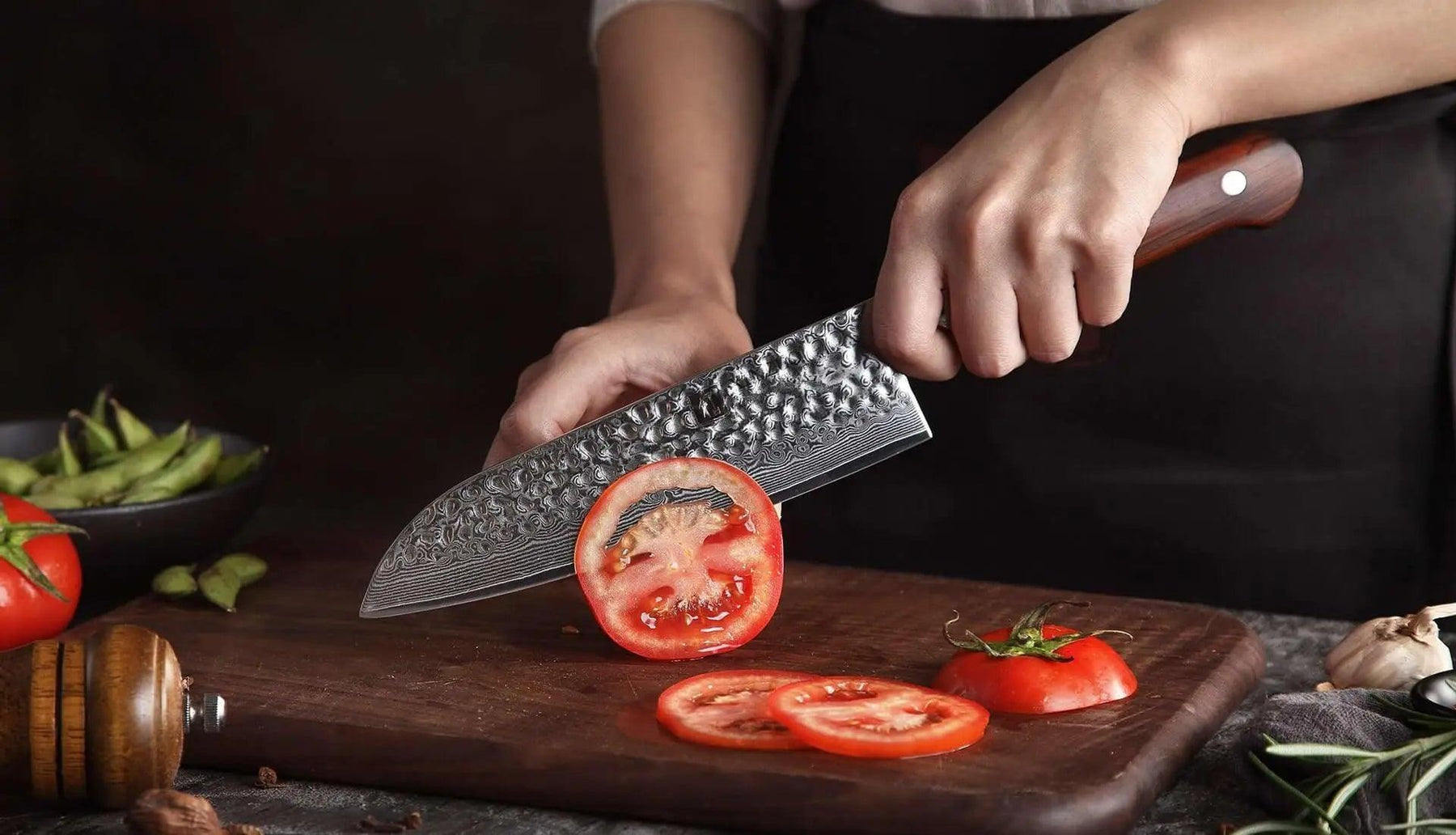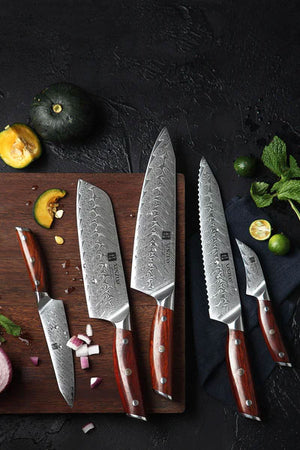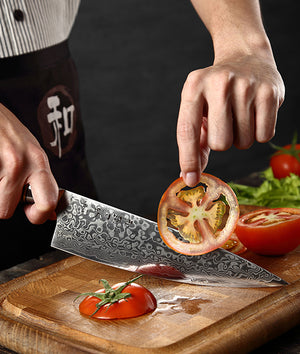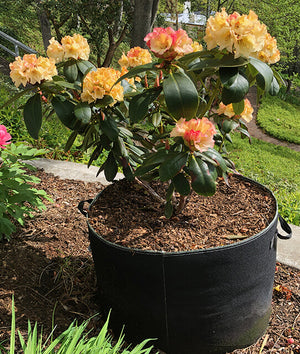
What is a Santoku Knife Used For?
The more you get into cooking, whether you're an experienced professional or a total amateur, the more you realize just how much choice there is when it comes to different tools you can use in the kitchen.
Whether you're looking at something like cutting boards or all-important knives, you have a lot of variety to choose from. Thus, if you want to find yourself something that suits your needs to the best thing you can do is learn about all your options.
Now, when it comes to kitchen knives, there are loads of different types, all of which boast specific designs and are made for very particular purposes. So, not only do you need to learn about all the knives that are available to you, but you need to decide exactly what it is you need and what it is that you're looking for.
Known for its exceptional versatility, the Santoku kitchen knives knife. The word, "Santoku", is Japanese, and it translates to "three virtues" or "three uses" - this is, supposedly, a reference to the kitchen knives, fish, and vegetables too.
The construction of the Santoku knife is very specific, designed with both versatility and precision in mind. Interestingly, however, it is often compared to the classic chef's knife - many people say that the Santoku knife is the Japanese version of a kitchen knives. And, while I can understand why this assertion is made so often, it's actually a bit more complicated than that.
So, in this article I'm going to tell you everything you need to know about Santoku knives. I'm going to tell you what a Santoku knife is - including some insight into its construction and what it's used for - as well as what the difference is between a Santoku knife and a chef's knife, how to sharpen a Santoku knife, and how to properly look after a Santoku knife.
And then, with this knowledge, you can find the best Santoku knife to suit your needs.
What is a Santoku Knife?
In the most basic terms, as I said above, a Santoku knife is a really nice and versatile kitchen knife that offers exceptional quality and utility. It's similar to chef knives, in some ways, but it certainly isn't the same.
So, with these things in mind, let's have a look at all the components that make a Santoku knife what it is.
The Construction of a Santoku Knife
The construction of most knives can be broken down into a few specific components that define their utility. That is, the blade, the edge, the tang, the handle, and the bolster. In addition, two other factors that influence the knife are balance and weight.
Blade
Important aspects of the blade of any knife include the material from which it's made, as well as the size (length and width) of the blade.
Santoku knives tend to be made from either traditional carbon steel or high-carbon stainless steel. These aren't the only materials that are used - some premium brands may very well use other types of steel for additional sharpness and durability.
However, mostly, Santoku knives from high-carbon stainless steel or traditional carbon steel are the most popular choices. If you want a knife that looks as good as it works Damascus Santoku knife with it's rippled water - like design is always a pleasure they have in your kitchen.
When it comes to length, Santoku knives tend to be a little bit shorter than your average chef's knife, between five and seven inches long. The blade is normally pretty wide and flat with a straight edge, Nice for scraping up ingredients to put in a pan or a bowl or right onto your plate.
Edge Profile
A Santoku knife is known for its sharpness. But another feature that you may find on a Santoku knife (although this isn't true for all of them) is a granton edge.
So, what's a granton edge? A granton edge means that the edge of the blade of your knife has lots of little divots or hollows - the purpose of this design feature is to prevent from sticking to the blade while your slicing and dicing.
Tang
There's no hard and fast rule for the type of tang Santoku knives have - it's possible for them to have either a partial or a full tang.
But, what is a tang? Put simply, the tang of a knife is the part of the blade that extends into the handle – full tang means that it extends the full length of the handle, while partial tang means that it extends into only part of the handle.
The different types of tangs influence many aspects of knives, including, among many things, the strength, durability, and balance of the knife. When it comes to Santoku knives, a full tang generally contributes to better balance and durability in the long run.
Handle
As I mentioned before, Santoku knife knives are often compared – this is due, mostly, to the fact that they're both quite versatile (among a few other factors). And one thing they do have in common is that they're normally quite attractive knives, and one factor in particular contributes to this is the Santoku knife.
This isn't, however, because they're made from one specific material - in fact, they can be made from a variety of materials, including things like wood, composite materials, and even different types of plastic. But whatever the handle is made from, you'll normally find that the handle of a Santoku knife appears in contrast to the sleek, shiny face of the blade.
The handle of a Santoku knife, however, exists in proportion to its blade – thus, it's shorter than that of a chef's knife.
Santoku knives usually boast an ergonomic design, boasting the utmost comfort, providing excellent grip and control.
Bolster
The bolster is the end bit of the blade on the handle side – that is, the point where the blade transitions into the handle.
Old-school Santoku knives used to feature quite a thick bolster and, consequently, a stark difference between the two main parts of the knife.
Modern Santoku knife, however, generally have more of a gradual transition from blade to handle. The effects the aesthetic of the knife (making it look a bit sleeker), but it also makes it easier to sharpen.
What is the Difference Between a Santoku Knife and a Chef's Knife?
Here are the main differences between Santoku knife knives.
1. The Shape of the Blade
You'll generally find that the blade of a Santoku knife is shorter, wider, and has a pretty straight edge. It'll probably have a rounded tip and it won't have a curved belly.
But a chef's knife normally features a longer, wider blade with a curved belly and a pointed tip.
2. The Thickness of the Blade
On average, the blade of a chef's knife is thicker and heavier than a Santoku knife - the latter tends to have a thinner blade.
3. The Purpose of the Knife
Santoku knives can do just about anything you like, and they're great for anything that requires precision. A chef's knife, on the other hand, is more about versatility, so it can be used for just about anything - it's often referred to as the workhorse of the kitchen.
4. The Length of the Knife
Chef's knives are normally longer than Santoku knives – on average, they're about eight to ten inches long, and five to seven inches long respectively.
5. The Handle of the Knife
The handles of both knives are pretty similar, but they differ in length - this keeps them in proportion. Thus, the is normally a bit longer than that of a Santoku knife.
6. The Cutting Technique
Chef's knives are quite versatile, and you can use them for most cutting techniques, including slicing, dicing, chopping, and rocking.
Santoku knives, on the other hand, are mostly suited to an up-and-down motion of cutting - they're great for precision slicing and chopping.
How to Sharpen a Santoku Knife and How to Look After and Maintain a Santoku Knife
Sharpening a Santoku knife is something you can do by following a pretty standard knife sharpening procedure. That is, using a damp whetstone and gliding both sides of the blade back and forth against it. When you're sharpening a Santoku knife, however, the desired angle is 15 to 20 degrees.
And, much like sharpening, maintaining a Santoku knife is also a pretty standard procedure, and you can follow general rules. That is, things like always protecting the blade, handwashing them, and how to store them. Making sure you properly look after and store your Santoku knife is one of the best things you can possibly do to ensure its durability and longevity – and, of course, make sure that the product is worth the money you’ve spent on it!



